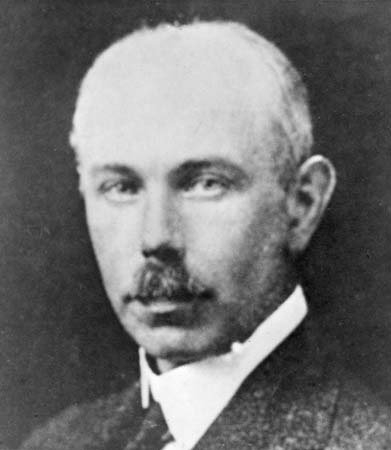Aston, Francis William
British physicist and chemist
born Sept. 1, 1877, Harborne, Birmingham, Eng.
died Nov. 20, 1945, Cambridge, Cambridgeshire
 British physicist who won the Nobel Prize for Chemistry in 1922 for his development of the mass spectrograph, a device that separates atoms or molecular fragments of different mass and measures those masses with remarkable accuracy. Aston used the mass spectograph to discover a large number of nuclides (nuclide), or nuclear species that differ in mass. The mass spectrograph is widely used in geology, chemistry, biology, and nuclear physics.
British physicist who won the Nobel Prize for Chemistry in 1922 for his development of the mass spectrograph, a device that separates atoms or molecular fragments of different mass and measures those masses with remarkable accuracy. Aston used the mass spectograph to discover a large number of nuclides (nuclide), or nuclear species that differ in mass. The mass spectrograph is widely used in geology, chemistry, biology, and nuclear physics.Aston was trained as a chemist, but, upon the rebirth of physics following the discovery of X-rays in 1895 and of radioactivity in 1896, he began in 1903 to study the creation of X-rays by the flow of current through a gas-filled tube. In 1910 he became an assistant to Sir J.J. Thomson (Thomson, Sir J.J.) at Cambridge, who was investigating positively charged rays emanating from gaseous discharges. During Aston's assistantship Thomson obtained, from experiments with neon, the first evidence for isotopes (atoms of the same element that differ in mass) among the stable (nonradioactive) elements.
After World War I, Aston constructed a new type of positive-ray apparatus, which he named a mass spectrograph. It showed that not only neon but also many other elements are mixtures of isotopes. Aston's achievement is illustrated by the fact that he discovered 212 of the 287 naturally occurring nuclides. Shortly after winning the Nobel Prize, Aston wrote the entry on atomic energy for the 13th edition (1926) of the Encyclopædia Britannica. (See the Britannica Classic: .)
- Gnosticism
- gnotobiosis
- go
- Goa
- Goajiro
- Goalundo Ghat
- goat
- goat antelope
- goatfish
- goatsbeard
- goatsucker
- Gobabis
- Gobat, Charles-Albert
- Gobelin Family
- Gobel, Jean-Baptiste-Joseph
- Gober, Robert
- Gobi
- Gobind Singh
- Gobineau, Joseph-Arthur, comte de
- goblin
- goblin shark
- goby
- Go- Daigo
- God (Anderson, Indiana), Church of
- God and Saints of Christ, Church of